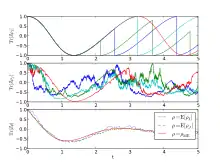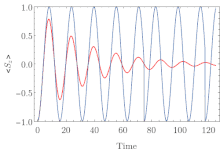Quantum jump method
The quantum jump method, also known as the Monte Carlo wave function (MCWF) is a technique in computational physics used for simulating open quantum systems and quantum dissipation. The quantum jump method was developed by Dalibard, Castin and Mølmer at a similar time to the similar method known as Quantum Trajectory Theory developed by Carmichael. Other contemporaneous works on wave-function-based Monte Carlo approaches to open quantum systems include those of Dum, Zoller and Ritsch and Hegerfeldt and Wilser.[1][2]
Method


The quantum jump method is an approach which is much like the master-equation treatment except that it operates on the wave function rather than using a density matrix approach. The main component of the method is evolving the system's wave function in time with a pseudo-Hamiltonian; where at each time step, a quantum jump (discontinuous change) may take place with some probability. The calculated system state as a function of time is known as a quantum trajectory, and the desired density matrix as a function of time may be calculated by averaging over many simulated trajectories. For a Hilbert space of dimension N, the number of wave function components is equal to N while the number of density matrix components is equal to N2. Consequently, for certain problems the quantum jump method offers a performance advantage over direct master-equation approaches.[1]
References
- Mølmer, K.; Castin, Y.; Dalibard, J. (1993). "Monte Carlo wave-function method in quantum optics". Journal of the Optical Society of America B. 10 (3): 524. Bibcode:1993JOSAB..10..524M. doi:10.1364/JOSAB.10.000524.
- The associated primary sources are, respectively:
- Dalibard, Jean; Castin, Yvan; Mølmer, Klaus (February 1992). "Wave-function approach to dissipative processes in quantum optics". Physical Review Letters. 68 (5): 580–583. arXiv:0805.4002. Bibcode:1992PhRvL..68..580D. doi:10.1103/PhysRevLett.68.580. PMID 10045937.
- Carmichael, Howard (1993). An Open Systems Approach to Quantum Optics. Springer-Verlag. ISBN 978-0-387-56634-4.
- Dum, R.; Zoller, P.; Ritsch, H. (1992). "Monte Carlo simulation of the atomic master equation for spontaneous emission". Physical Review A. 45 (7): 4879–4887. Bibcode:1992PhRvA..45.4879D. doi:10.1103/PhysRevA.45.4879. PMID 9907570.
- Hegerfeldt, G. C.; Wilser, T. S. (1992). "Ensemble or Individual System, Collapse or no Collapse: A Description of a Single Radiating Atom". In H.D. Doebner; W. Scherer; F. Schroeck, Jr. (eds.). Classical and Quantum Systems (PDF). Proceedings of the Second International Wigner Symposium. World Scientific. pp. 104–105.
Further reading
- A recent review is Plenio, M. B.; Knight, P. L. (1 January 1998). "The quantum-jump approach to dissipative dynamics in quantum optics". Reviews of Modern Physics. 70 (1): 101–144. arXiv:quant-ph/9702007. Bibcode:1998RvMP...70..101P. doi:10.1103/RevModPhys.70.101.
External links
- mcsolve Quantum jump (Monte Carlo) solver from QuTiP for Python.
- QuantumOptics.jl the quantum optics toolbox in Julia.
- Quantum Optics Toolbox for Matlab
